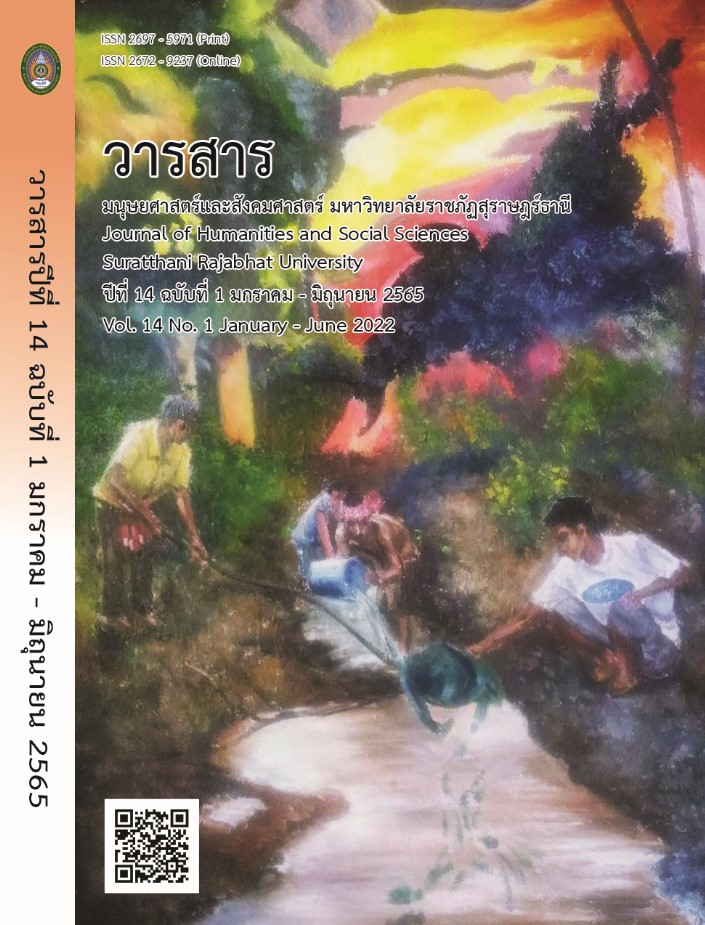The Value - Added Concept of the Contemporary Cultural Products by Certification Mark
Main Article Content
Abstract
This article aims to suggest developing the concept of the rules of the contemporary cultural product by certification mark, the importance of the contemporary cultural product certification mark, and the certification mark for contemporary cultural products in foreign countries such as the European Union and New Zealand. The results showed that the use of certification marks could show the uniqueness of the product that conveys that the consumer can add value to the product. However, the certification mark has not been used on cultural products, which is a standard that can be applied to all types of products and geographical indications have restrictions on the protection of goods from contemporary culture because the product must be linked to a geographical source. Therefore, there should be a development of a certification mark for contemporary cultural products. There should be a set of rules that can be adjusted according to the era, the participation of the successors of knowledge, and criteria for checking the certification mark to build consumer confidence. The development of the contemporary cultural product certification mark will give the Ministry of Commerce tools to communicate to consumers that will lead to product added value, enhanced competitiveness, and help in safeguarding the sustainable intangible cultural heritage and more concrete.
Article Details

This work is licensed under a Creative Commons Attribution-NonCommercial-NoDerivatives 4.0 International License.
All published manuscripts have been verified by peer-peer professors in the fields of humanities and social sciences. Reprinting of the article must be authorized by the editorial staff.
References
เกวลิน ต่อปัญญาชาญ. (2561, มกราคม - มิถุนายน). สิ่งบ่งชี้ทางภูมิศาสตร์และการรับรอง
ผลิตภัณฑ์พิเศษซึ่งรับรองการผลิตด้วยวิธีดั้งเดิมกับการคุ้มครองภูมิปัญญาท้อง
ถิ่นอาหารไทย. วารสารสุโขทัยธรรมาธิราช, 31(1), 36 - 53.
เกวลิน ต่อปัญญาชาญ. (2564, มกราคม - มิถุนายน). การศึกษาเปรียบเทียบสิทธิของ
ผู้สืบทอดองค์ความรู้ตามพระราชบัญญัติส่งเสริมและรักษามรดกภูมิปัญญาทาง
วัฒนธรรม พ.ศ. 2559 และอนุสัญญาว่าด้วยการสงวนรักษามรดกทางวัฒนธรรม
ที่จับต้องไม่ได้ ค.ศ. 2003. วารสารนิติศาสตร์ มหาวิทยาลัยนเรศวร, 14(1),
- 25.
กัมพล แสงเอี้ยม. (2559). วัฒนธรรมร่วมสมัยสู่การปรับเปลี่ยนรูปแบบงานศิลปหัตถกรรม
ผ้าทอท้องถิ่น. ศิลปกรรมสาร, 11(1), 1 - 12 https://fineart.tu.ac.th/
mainfile/journal/11-2559-1/1.pdf.
ทวีพฤทธิ์ ศิริศักดิ์บรรจง. (2556). มาตรการคุ้มครองการแสดงออกทางวัฒนธรรมแบบ
ประเพณี : ศึกษากรณีผ้าไหมสุรินทร์. วิทยานิพนธ์ น.ม. (กฎหมาย
เอกชนและกฎหมายธุรกิจบัณฑิตวิทยาลัย). กรุงเทพฯ: มหาวิทยาลัย
ธรรมศาสตร์.
ปัญญา เทพสิงห์. (2552). บทวิจารณ์หนังสือ “ศิลปวัฒนธรรมร่วมสมัยบนความหลาก
หลายและสับสน” ของสุริชัย หวันแก้ว และกนกพรรณ อยู่ชา. วารสารสถาบัน
วัฒนธรรมและศิลปะ (สาขามนุษยศาสตร์และสังคมศาสตร์) มหาวิทยาลัย
ศรีนครินทรวิโรฒ, 14(2), 7 - 10. https://so02.tci-thaijo.org.
เปรม ถาวรประภาสวัสดิ์. (2562). พระราชบัญญัติส่งเสริมและรักษามรดกภูมิปัญญาทาง
วัฒนธรรม พ.ศ. 2559: การรักษามรดกทางวัฒนธรรมที่จับต้องไม่ได้. www.
parliament.go.th/ewtadmin/ewt/parliament_parcy/ewt_dl_link.php
?nid=54975&filename=house2558.
เพ่ง บัวหอม. (2560). ศิลปวัฒนธรรมเพื่อสร้างคุณค่าและมูลค่าทางเศรษฐกิจชุมชน.
https://www.bangsaray.go.th/images/sub_1399993834/
ศิลปวัฒนธรรมเพื่อสร้างคุณค่าและมูลค่าทางเศรษฐกิจชุมชน.pdf
วัส ติงสมิตร. (2545). คำอธิบายกฎหมายเครื่องหมายการค้า. กรุงเทพฯ: นิติธรรม.
สุกัญญา สุจฉายา. (2555, สิงหาคม - 2556, มกราคม). ผู้สืบทอดเป็นผู้ถือครอง มิใช่
เจ้าของมรดกภูมิปัญญาทางวัฒนธรรม. วารสารไทยศึกษา, 8(2), 97 - 121.
สำนักงานศิลปวัฒนธรรมร่วมสมัย. (2561). ความหมายของคำว่า “ศิลปวัฒนธรรมร่วมสมัย”.
Brudvig, S. (2015). Consumer-based brand trust scales: validation and assessment.
Revolution in Marketing. Market Driving Changes Springer, Cham, 17 - 21.
https://doi:10.1007/978-3-319- 11761-4_12.
European Commission. (2021). Commission publishes study on geographical
indications (GI) and traditional specialities guaranteed (TSG) protected in
the EU. https://ec.europa.eu/info/news/commission-publishes-
study-geographical-indications-gi-and-traditional-specialities-guaranteed-tsg-
protected-eu-2021-mar-02_en
European Commission. (2021). Traditional speciality guaranteed. https://ec.
europa.eu/info/food-farming-fisheries/food-safety-and-quality/certification/
quality-labels/quality-schemes-explained_en.
Habermas, J. (1998). The Inclusion of the Other: Studies in Political Theory.
Germany: Massachusetts Institute of Technology.
Harmsworth, G. (2005). Report on the incorporation of traditional values/tikanga
into contemporary Māori business organisation and process. https://
www.landcareresearch.co.nz/uploads/public/researchpubs/Harms
worth_report_trad_values_tikanga.pdf.
Regulation (EU) No. 1151/2012 of THE EUROPEAN PARLIAMENT AND OF THE COUN
CIL of 21 November 2012.
Stavenhagen, R. (2011). Making the Declaration on the Rights of Indigenous People
Work: The Challenges Ahead, in Reflections on The UN Declaration on
the Rights of Indigenous People. UK: Hart Publishing.
Stefano, M. L., Davis, P., & Corsane, G. (2012). Safeguarding Intangible Cultural
Heritage. UK: The Boydell.
Toi iho. (2021). Tena koutou Katoa Nau Mai, Piki Mai, Haere Mai Welcome to Toi
Iho – 2022.. http://www.Toiiho.co.nz/.
Traditional Speciality Guaranteed. (2020). https://ec.europa.eu/info/food-farming-
fisheries/food-safety-and-quality/certification/quality-labels/
quality-schemes-explained_en.
Zografos, D. (2010). Intellectual Property Traditional Cultural Expressions. UK: Ed
ward Elgar.


